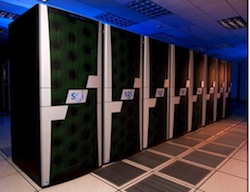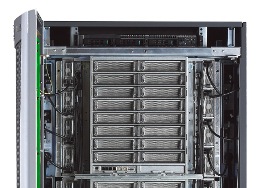SGI ICE Supercomputer and Advanced Manufacturing
Due to its cost and complexity, high performance computing (HPC) historically has been restricted to the big guys – government labs, the military, large corporations, and well-heeled academic institutions (if that’s not an oxymoron these days).
 The small to medium sized manufacturers (SMMs) have been left out in the cold, their noses pressed longingly against the showroom window, lacking the funds, trained personnel and infrastructure to move beyond their workstations and into the realm of supercomputing.
The small to medium sized manufacturers (SMMs) have been left out in the cold, their noses pressed longingly against the showroom window, lacking the funds, trained personnel and infrastructure to move beyond their workstations and into the realm of supercomputing.
All that is changing. Cloud computing provides HPC services without costing an arm and a leg; essential software – such as solvers for computational fluid dynamics (CFD) and finite element analysis (FEA) – are coming down in price and are easier to use; and a number of OEMs have introduced supercomputers that are affordable and scalable.
Enter the SGI ICE 8400
SGI is one of them. The SGI ICE 8400 was introduced at last year’s SC11 show in Seattle. Two weeks ago it passed an impressive milestone – achieving top performance for 64-, 32-, 16-, 8-, and 4-socket configurations for the SPECMPIL2007 benchmark. This is SPEC’s benchmark suite for evaluating MPI-parallel, floating point, and compute intensive performance.
The SGI ICE platform is hot and ideally suited for work in manufacturing, SGI’s second largest market after the private sector.
Big manufacturers are buying systems with tens or hundreds of racks, primarily for modeling, simulation and analysis, which includes compute intensive CFD and FEA. Customers include major companies in the automotive, aviation, consumer appliance, bioscience sectors, and even Formula 1 racing.
But what about the SMMs? Are they missing out yet again? Not according to Bill Mannel, vice president, Product Marketing at SGI. He notes, “Because of (the systems) level of integration, SGI ICE is seeing a lot of interest from small and medium sized customers.”
He explains that these customers, many of them manufacturers, are considering SGI ICE because of SGI’s rigorous pre-installation configuring and testing designed to make sure the system is ready to run when it’s delivered to the customer. “You plug it in and it works,” says Mannel.
Part of SGI’s Start Up and Go program is to make sure the platform is working properly and totally integrated with its applications software – for example, SGI’s open source OpenFOAM CFD. Testing is done in SGI’s manufacturing facility in Chippewa Falls, Wisc. that also housed the company’s engineering division. Because engineering is nearby, last-minute issues are quickly resolved before shipment to the customer.
Once at the customer site, Mannel says that SGI has installed multi-rack systems in a matter of hours. According to the company, SGI ICE has scored nearly 100 percent in customer satisfaction on a poll recently conducted by SGI among current ICE customers.
For the SGI ICE 8400, the other big selling point is the system’s scalability. Although SGI ICE comfortably supports multi-petaflop sized installations at Fortune 500 manufacturing companies, systems targeted to SMMs can be configured at a half a rack. Then, as the customer’s computational needs grow over time, the system can be scaled all the way to the petaflop range.
Powered by AMD processors, SGI ICE 8400 supports Red Hat Linux or Novell SUSE Linux and includes an SGI Management Center, a GUI-based systems management console for monitoring system operations from a single point of control.
Applications on ev en the smallest configurations generate massive amounts of data. This is why the SGI ICE system includes single- or dual-plane integrated Infiniband that can be cabled into four different topologies, providing the flexibility needed to meet a variety of workloads.
en the smallest configurations generate massive amounts of data. This is why the SGI ICE system includes single- or dual-plane integrated Infiniband that can be cabled into four different topologies, providing the flexibility needed to meet a variety of workloads.
Another plus is SGI’s outstanding relationship with its independent software vendors (ISVs). Because SGI does such a thorough job of integrating the system hardware and software before delivering the SGI ICE 8400 to its new owner, the ISVs report that their users experience fewer problems related to how the system was set up and administered.
Overcoming the Hurdles
With prices starting at $150,000, SGI ICE is affordable. But if pricing is a relative non-issue, there are other barriers the SMMs must overcome before moving off their workstations running 2D and 3D CAD and transitioning into the world of advanced manufacturing. CFD solvers like Fluent and OpenFOAM and FEA and multiphysics simulation software from companies like SIMULIA, have become easier to use, but still require specialized knowledge. Mannel advises smaller companies to move ahead cautiously, starting by attending training sessions on HPC and its attendant software at classes given by SGI or its software partners and 3rd party vendors.
Another helpful approach is to “kick the tires” before buying. Without any capital outlay, SMMs can take advantage of SGI’s Cyclone cloud services to run their data intensive jobs, giving them a sense for what HPC can do for their users and their company without having to build internal infrastructure. Cyclone is accessed over the Internet and is available 24x7 from anywhere in the world. It provides computational capabilities in such domains as computational biology, computational chemistry and materials, CFD, FEA, computational electromagnetic, and ontologies for the Semantic Web and data mining.
SGI provides Infrastructure as a Service (IaaS) for running customer’s data intensive applications, and Software as a Service (SaaS) typified by their agreement with LS DYNA, which allows users to perform crash analysis in the cloud.
For those SMM customers who wish to install their own system, the road to HPC will be a lot smoother. The SGI ICE 8400 system provides all the power that’s needed in a tightly integrated, highly scalable package that requires less self-management and self-configuration and can grow as the small manufacturer builds its business and one day joins the ranks of the big guys.










